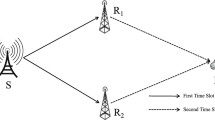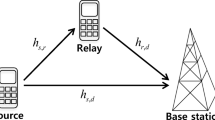Abstract
This paper proposes a cooperative diversity transmission scheme by superposition coding relaying (SC-relaying) for a wireless system with multiple relays. In this scheme, two layer signals, i.e., signal \({x_1}\) and \({x_2}\), are transmitted from a base station (BS) in the first and the second time slot, while signal \({x_1}\) is also forwarded from multiple relays to a user in the second time slot. The two layer signals (\({x_1}\) and \({x_2}\)) meet and superimpose with each other in the air in the second time slot. Then successive interference cancellation (SIC) is used for decoding at the user. In this paper, the optimal power allocation that maximizes the sum throughput of \({x_1}\) and \({x_2}\) is first studied. Then the optimal number of selected relays and optimal transmission rate at the BS is derived. Finally the outage probability and diversity gain of the transmission of \({x_1}\) and \({x_2}\) is evaluated for system robustness. Simulation results show that the proposed scheme realizes the goal of increasing spectral efficiency and enhancing system robustness.





Similar content being viewed by others
References
Tarokh, V., Seshadri, N., & Calderbank, A. R. (1998). Space-time codes for high data rate wireless communication: Performance criterion and code construction. IEEE Transactions on Information Theory, 44(2), 744–765.
Alamouti, S. M. (1998). A simple transmit diversity technique for wireless communications. IEEE Journal on Selected Areas in Communications, 16(8), 1451–1458.
Bauch, G., & Malik, J. S. (2006). Cyclic delay diversity with bit-interleaved coded modulation in orthogonal frequency division multiple access. IEEE Transactions on Wireless Communications, 5(8), 2092–2100.
Kwon, U. K., & Im, G. H. (2009). Cyclic delay diversity with frequency domain turbo equalization for uplink fast fading channels. IEEE Communications Letters, 13(3), 184–186.
Sendonaris, A., Erkip, E., & Aazhang, B. (2003). User cooperation diversity-part I: System description. IEEE Transactions on Communications, 51(11), 1927–1938.
Sendonaris, A., Erkip, E., & Aazhang, B. (2003). User cooperation diversity-part II: Implementation aspects and performance analysis. IEEE Transactions on Communications, 51(11), 1939–1948.
Laneman, J. N., Tse, D. N. C., & Wornell, G. W. (2004). Cooperative diversity in wireless networks: Efficient protocols and outage behavior. IEEE Transactions on Information Theory, 50(12), 3062–3080.
Yuksel, M., & Erkip, E. (2004). Broadcast strategies for the fading relay channel. In Proceedings of the IEEE MILCOM, Monterey, CA, November 2004, pp. 1060–1065.
Larsson, E. G., & Vojcic, B. R. (2005). Cooperative transmit diversity based on superposition modulation. IEEE Communications Letters, 9(9), 778–780.
Popovski, P., & de Carvalho, E. (2008). Improving the rates in wireless relay systems through superposition coding. IEEE Transactions on Wireless Communications, 7(12), 4831–4836.
Jia, X., Fu, H., Yang, L., & Zhao, L. (2011). Superposition coding cooperative relaying communications: Outage performance analysis. International Journal of Communications Systems, 24, 384–397.
Jia, X., & Yang, L. (2011). Interaction of multiplexing gains and power exponents allocation of two-level superposition coding relaying. European Transactions on Telecommunications, 22, 352–366.
Wei, D. (2011). Research on the optimization of the wireless transmission technology for layered source coding. Ph.D. thesis, chapter 4, Beijing University of Posts and Telecommunications.
Tse, D. N. C., & Viswanath, P. (2005). Fundamentals of wireless communication. Cambridge: Cambridge University Press.
Liu, Y., Wang, W., Peng, M., & Zhu, S. (2012). Optimized layered multicast with superposition coding in cellular systems. Wireless Communications & Mobile Computing, 12(13), 1147–1156.
Liu, Y., Wang, W., Peng, M., & Wei, D. (2013). Optimal joint rate and power allocation for layered multicast with superposition coding in cellular systems. Wireless Networks, 19(1), 69–81.
Cover, T. M. (1972). Broadcast channels. IEEE Transactions on Information Theory, 18(1), 2–14.
Bergmans, P. P. (1973). Random coding theorem for broadcast channels with degraded components. IEEE Transactions on Information Theory, IT–19, 197–207.
Bergmans, P. P. (1974). A simple converse for broadcast channels with additive white Gaussian noise. IEEE Transactions on Information Theory, 20, 279–280.
Cover, T. M., & Thomas, J. A. (1991). Elements of information theory. New Jersey: Wiley.
Zhang, R., & Hanzo, L. (2011). A unified treatment of superposition coding aided communications: Theory and practice. IEEE Communications Surveys & Tutorials, 13(3), 503–520.
Tse, D. N. C., Viswanath, P., & Zheng, L. (2004). Diversity-multiplexing tradeoff in multiple-access channels. IEEE Transactions on Information Theory, 50(9), 1859–1874.
Acknowledgments
This work was supported in part by the National Science Technology Major Projects under Grant No. 2013ZX03001025-002, Huawei innovative research project under Grant No. A2014028, the Fundamental Research Funds for the Central Universities under Grant No. 2013RC0202, and by the National Natural Science Foundation of China under Grant Nos. 61372117, 61471055, 61201150, 61101107, 61302090.
Author information
Authors and Affiliations
Corresponding author
Rights and permissions
About this article
Cite this article
Liu, Y., Man, Y., Song, M. et al. A cooperative diversity transmission scheme by superposition coding relaying for a wireless system with multiple relays. Wireless Netw 21, 1801–1817 (2015). https://doi.org/10.1007/s11276-014-0877-9
Published:
Issue Date:
DOI: https://doi.org/10.1007/s11276-014-0877-9




